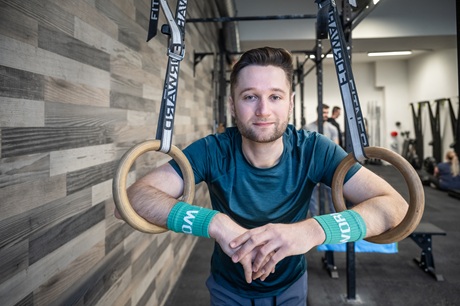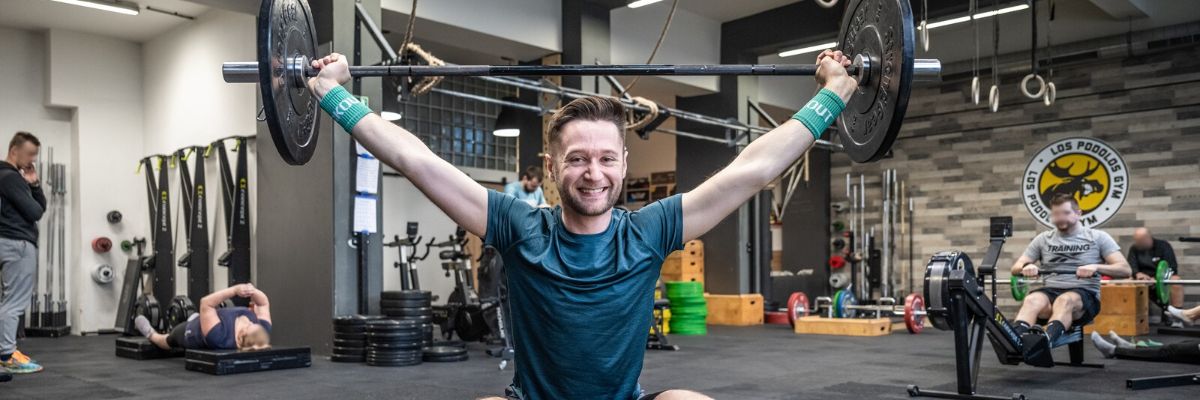
Our microbiome largely depends on what we eat, says microbiologist Michal Kraus
04. 06. 2025
As a kid, he’d spend hours spying on grasshoppers, roly-polies, and ants, totally enthralled. And that love of all things creepy-crawly has never left Michal Kraus, now a researcher at the Institute of Microbiology of the CAS. These days, though, it’s not six- or eight-legged critters he studies, but the ones living deep inside our guts.
*
If your microbiome had an Instagram account, what would its favorite hashtags be?
Nothing too positive, to be honest – it’s not exactly in great shape right now. It would probably be along the lines of #cooked, #notfeelinggreat, or #sendhelp! I know all too well what it’s like to have a less-than-harmonious relationship with your intestinal roommates. And that’s actually what sparked my interest in the microbiome in the first place.
What exactly do we mean by “microbiome”?
It’s the community of all the microorganisms that live in and on our bodies. Like a private zoo made up of bacteria, yeasts, fungi, viruses, and protozoa. We might not be able to see it with the naked eye, but it’s no small thing – there are actually more microbial cells inside us than human ones, and their genetic information outweighs ours by a factor of about 150. In other words, our microbes can manage about 150 times more than we can!
Sounds like a pretty powerful zoo... Which enclosure is the busiest?
The colon, by far. It’s teeming with organisms – and for good reason. These microbes play a major role in digestion. Unlike us, they can break down dietary fiber, for instance. They munch on it and, in the process, produce what are known as SCFAs – short-chain fatty acids – which our gut cells use as their main energy source. These compounds also help reduce inflammation.
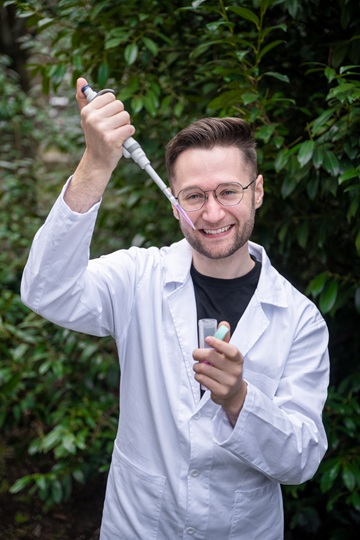
Michal Kraus from the Institute of Microbiology of the CAS. (CC)
I’m guessing that’s just the start of these little guys’ superpowers…
You bet! They’re involved in nearly every aspect of our lives. They protect us from pathogens, help the nervous system develop, and even produce certain hormones, which can have an impact on our mood. About 70% of all immune cells are located in the digestive tract, so the gut crew is also key for maintaining a healthy immune system. And the more diverse your microbial zoo, the better off you are.
So the more species of microorganisms we host, the healthier we are?
That’s a fairly simplified way of putting it, but yes. The composition of our microbiome is key. Some estimates suggest that disruptions or imbalances in the microbiome are linked to up to 90% of all diseases.
The microbiome is behind everything, then?
It’s starting to look that way. We’re finding that the microbiome plays a role even in diseases where we wouldn’t have expected it before. For instance, my colleagues at the Institute of Experimental Medicine of the CAS and I are currently using mouse models to study how microbiome quality affects the progression of amyotrophic lateral sclerosis – ALS – a neurodegenerative disease where the nerve cells controlling muscles gradually die off. Stephen Hawking, the world-renowned astrophysicist, had ALS.
You focus on finding links between the gut microbiota, diet, and various diseases. What are you working on right now?
We’re currently looking at how high-protein diets influence the development of colon cancer, and whether freshwater algae could help calm intestinal inflammation. As part of my PhD, I’m exploring how a ketogenic diet affects the onset and progression of multiple sclerosis (MS).
That diet is popular with celebrities, right?
To a certain degree – mainly because it can help with weight loss. But it’s very restrictive, so I wouldn’t recommend experimenting with it on your own. Scientists originally developed the ketogenic diet – which is high in fat and extremely low in carbs – as a treatment for epilepsy. Specifically for cases where patients didn’t respond to any medication.
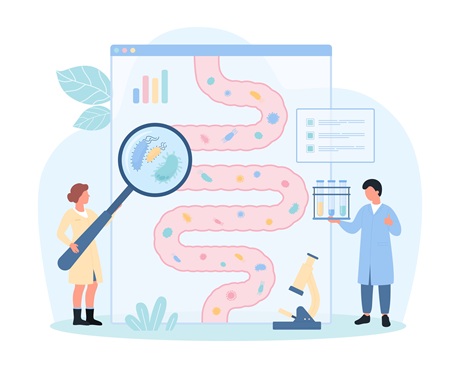
Disruptions or imbalances in the microbiome are connected to up to 90% of all diseases.
Did it work?
Yes, it turned out that this kind of dietary regimen could completely stop seizures in some patients. Now, researchers are testing the potential of the keto diet for other conditions. And in MS patients, the early results look promising. In our mouse studies, we’re mainly examining how the diet affects both the microbiome and the metabolism of a commonly used MS drug.
So a change in diet really can work wonders?
Pretty much. The state of our microbiome – and by extension our overall health – largely depends on what we eat. A healthy microbiome starts with a diverse, fiber-rich diet. But here’s the catch: one kind of fiber isn’t enough. Researchers have found that to keep our gut flora in good shape, we should eat at least thirty different plant-based fiber foods a week. And that’s not easy! Try counting them sometime. There are even apps for that, though pen and paper will do.
Are you saying that if I eat an apple, I get a point?
Exactly. One food = one point. You eat a whole-grain roll – you get a point. Try some broccoli – another point. And so on. Herbal teas and infusions like coffee or tea count as a quarter of a point. But if you eat a second apple later that week, you don’t up your score.
What about junk food – like a hotdog? Would that cost me points?
Luckily, there are no minus points. But the idea is to show that if you want diversity in your gut, you need diversity on your plate too. Eating just rice and chicken on repeat, as some fitness plans suggest, really isn’t the way to go.
How else can we give our microbiome a boost?
Fermented foods work wonders. That’s because they contain live bacteria that can help support the ones already in your gut. So fermented veggies like sauerkraut or kimchi, or drinks like kombucha or milk kefir and water kefir, are the ultimate gut tune-up. Fun fact: the word kefir comes from the Turkish keif, meaning “to feel good.” Probiotic supplements also contain friendly bacteria.
|
WATER KEFIR, STEP BY STEP
To make water kefir, you will need so-called tibicos grains that contain the necessary microorganisms – you can get them at specialty stores. Put them into a large mason jar, pour in a sugar solution (4 g of sugar per 100 ml of water), and add some dried fruit, like figs. Secure a napkin over the top and let it ferment at room temperature for 1–2 days. Then strain the solution to remove the grains. Add fresh or dried fruit, juice, or syrup to taste and let it ferment for another day in an airtight container – ideally plastic. “You’ll get a carbonated drink that your gut will love. And the tibi grains are like a tamagotchi – you can ‘raise’ them,” says Michal Kraus with a laugh. |
Are they worth taking from time to time?
After acute digestive issues or after taking antibiotics, yes. And we now have two approved probiotic formulations here in the Czech Republic for treating specific conditions. But those are still just the first signs of what’s to come. There’s definitely no universal miracle pill that makes every microbiome flourish. Think of probiotics as the cherry on top – what really matters is the cake itself: a varied diet. Without that, the cherry’s useless.
A bowl of kimchi then will do a better job than probiotics?
Without a doubt! And it’s much cheaper, too. Along with live bacteria, fermented foods also contain their metabolic by-products, which further support the microbiome. If you eat a few spoonfuls of sauerkraut every evening, amazing things start happening inside you – in the best possible way. (laughter) I’m living proof of that.
So sauerkraut helped you patch things up with your rowdy gut roommates?
Not yet entirely, but there’s been some major improvement. And not just because of the sauerkraut – my whole approach to food has changed. I used to have recurring infections, low-grade fevers lasting for weeks on end, and digestive problems that had me spending way more time in the bathroom than I’d have liked. The doctors were stumped. So as an immunology student, I started investigating on my own. I began to suspect the root cause might lie in my microbiome. I overhauled my diet completely – and within a few months, I felt significantly better. From there, combining microbiome research with immunology for my PhD was the logical next step for me.
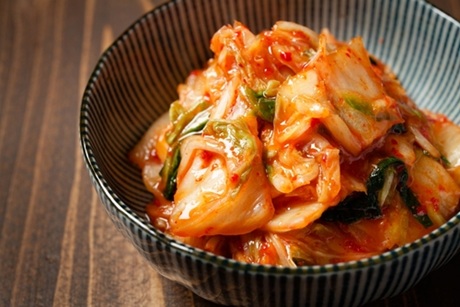
Fermented veggies like kimchi are the ultimate gut tune-up.
So your health issues helped you choose your field of focus.
More or less. Since I was a kid, I had always been fascinated by all sorts of creepy-crawlies. Instead of playing with other kids, I preferred to hang out with grasshoppers in meadows, flipping over stones in the forest to catch roly-polies and spiders living underneath. At home, I’d fatten up diving beetle larvae or dragonfly nymphs so I could watch them grow and then set them free again. I kept all kinds of creatures, including snails, as pets.
I’m guessing your parents weren’t thrilled about that…
Not really – especially when the snails escaped and left slimy trails all over the walls. (laughter) In school, I started going to biology Olympiads and then to summer science camps for young chemists and biologists in Běstvina, where my love of science really took off. Only I gradually moved on from forest bugs to ones you can’t see with the naked eye – like cancer cells – and eventually, I was drawn in by that microscopic gang living in our gut.
So have bugs lost their appeal?
Not at all. Lock me in the invertebrate section of the zoo for a day and I’ll be the happiest guy in the world. And it’s pretty lively at my place, too – I’ve got spiders, scorpions, mantises, geckos, and, of course, ants.
You keep ants at home on purpose?
Of course. And I highly recommend it! They may not be cuddly pets, but you can observe how their society works in amazing detail. It’s like peeking into an anthill. You can sit by the formicarium [ant farm], feed them, and just watch the hustle and bustle for hours.
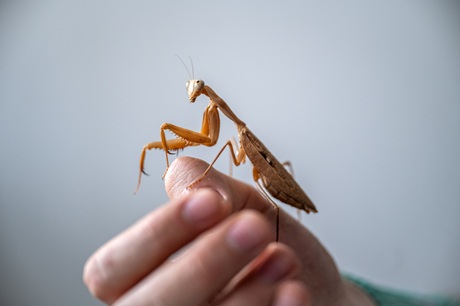
Rhonda the Praying Mantis – one of Michal's pets. (CC)
Better than TV almost…
Netflix doesn’t stand a chance! It completely clears my head. The same goes for rave parties, which I like to go to now and then. The atmosphere and energy totally sweep you away. Loud electronic music, crowds of dancing people – I can keep going till morning. And for the record, I don’t do drugs. I also enjoy listening to drum and bass in the lab – the heavy rhythm really gets me going and makes me more productive.
Do your colleagues enjoy it, too?
I usually spare them. A lot of people think my type of music sounds like inhuman noise, so if I’m not alone in the lab, I switch to headphones.
So, ant-watching and rave parties – how else do you relax?
A fairly new thing for me is active rest through sport. As a kid, gym class was traumatic for me. In team sports, I preferred to sit on the bench, and jumping over the vaulting horse was pure torture. But as an adult, health issues forced me to get moving. I started running and then, two years ago, I discovered CrossFit.
What is that, exactly?
It’s a fitness regimen that combines weightlifting, gymnastics, and cardio. The workouts are really intense, but I love the variety. The exercises constantly change – one minute you’re lifting weights, then you’re on the rowing machine, and next thing you know, you’re doing gymnastic ring work. The great thing is it doesn’t matter what fitness level you’re at. It’s totally up to you whether you load eighty kilos onto the Olympic bar – which weighs twenty kilos on its own – or just ten.
How much do you lift?
I can manage seventy-five kilos now, which is more than my own weight. For someone who was never athletic, that surprised a lot of people around me. But I’m still basically a beginner. I train up to four times a week, but there are tons of things I still can’t do. Right now, I’m working on handstands and walking on my hands. And it’s a real struggle!
And how’s your microbiome handling it?
I’m sure it’s loving it. Exercise can actually affect microbiome diversity. But the real foundation is diet, and I try to keep my gut community happy with that too.
So what have you treated it to today?
For breakfast, I had my favorite overnight oats (with yogurt). In the morning, I added nuts, apple, and dried fruit. The bacteria in my belly were squealing with delight. I do whatever I can to make sure my microbiome feels up to using hashtags like #yum, #feelinggreat, or #thriving.
|
Mgr. MICHAL KRAUS
Michal Kraus studied immunology at the Faculty of Science of Charles University in Prague. As part of his PhD research at the Laboratory of Cellular and Molecular Immunology at the Institute of Microbiology of the CAS, he is exploring how diet and modifications of the gut microbiome could be used to treat autoimmune diseases. He is also active in science communication, for example as part of the Zeptej se vědce! (Ask a Scientist!) project. |
*
The interview first came out (in Czech) in the 1/2025 issue of A / Easy:
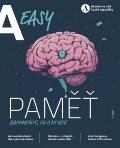
1/2025 (version for browsing)
1/2025 (version for download)
Written and prepared by: Radka Římanová, External Relations Division, CAO of the CAS
Translated by: Tereza Novická, External Relations Division, CAO of the CAS
Photo: Jana Plavec, External Relations Division, CAO of the CAS; (Crossfit photos taken in Los Podolos Gym); Shutterstock
 The text and photos labeled CC (and the bio photo) are released for use under the Creative Commons license.
The text and photos labeled CC (and the bio photo) are released for use under the Creative Commons license.
Read also
- Vice-Presidents of the CAS set priorities for 2025–2029 term
- Public Hearing: “Making Sense of Open Science”
- SUNER-C concludes after three years dedicated to the renewable energy future
- A trapped state: The pandemic impact on public attitudes, trust, and behavior
- Aerial archaeology: Tracing the footsteps of our ancestors from the sky
- Archaeologists uncover ancient finds along Prague Ring Road
- The ABCs of writing: Why did its invention mark a turning point for humankind?
- We learn, remember, forget… What can memory actually do? And can we outsmart it?
- New Center for Electron Microscopy in Brno opens its doors to global science
- The hidden lives of waste: What can we learn from waste workers and pickers?
Contacts for Media
Markéta Růžičková
Public Relations Manager
+420 777 970 812
Eliška Zvolánková
+420 739 535 007
Martina Spěváčková
+420 733 697 112

